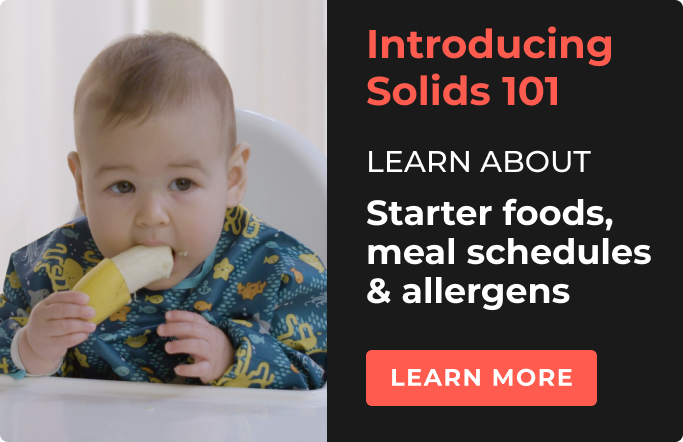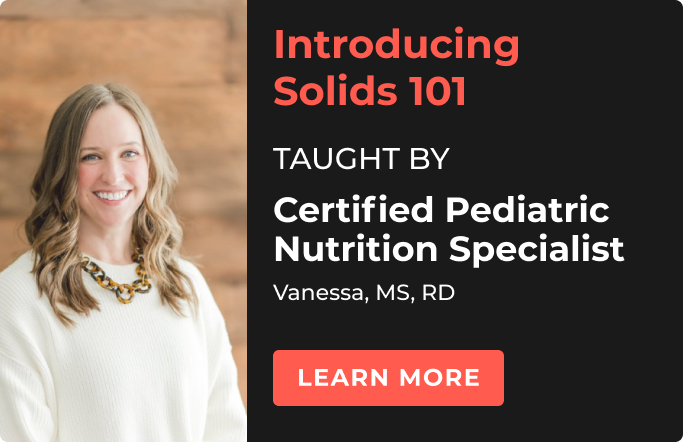There’s generally one aspect to starting solids that makes a parent’s heart beat just a little faster… allergens. After all, no parent wants to feel like they are putting their child in life-threatening danger, and especially not with the food they’re putting on their plate. But introducing allergens is a crucial part of the solids process, and you can take some of the anxiety away by knowing you are introducing each allergen as safely as possible.

So how do you do that? First, our expert and pediatric nutritionist Vanessa says you need to be aware of the most common food allergies in young children, or what she dubs “The Top 9:”
1. Cow's milk
2. Soy
3. Peanuts
4. Tree nuts (think: cashews, pistachios, walnuts)
5. Eggs
6. Wheat/Gluten
7. Shellfish
8. Fish
9. Sesame
Remember, this is by no means a comprehensive list of all potential food allergens and food intolerances, but it is a good starting place for you to know which particular foods to introduce with caution.
Okay, so you know what the major allergenic foods are… but when do you start giving them? Though previous philosophies thought there may be some benefit to waiting, Vanessa (and the American Academy of Pediatrics) say that’s been disproven, and that you should introduce allergens early and often.
In fact, unless you or close family members have a history of food allergies or your baby has a history of severe eczema, you can start incorporating allergens into your little one’s diet after the first few feeds. Vanessa does suggest getting a few feedings under your belt, though, just so you can make sure your baby is tolerating foods well in general before adding in high-risk options.
When it is time to introduce a potential food allergen for the first time, you want to make sure:
1. You are doing so at home, when there is not a lot going on, so you can fully focus on your baby.
2. You are introducing allergens one at a time and in small doses. (Vanessa suggests a pea-sized serving to start.)
3. You have an antihistamine, like Children’s Bendadryl, on-hand just in case your child experiences an allergic reaction, and you know the appropriate dosage, as given to you by your child’s pediatrician.
4. You and your caregivers know the signs of an allergic reaction, which may include hives, flushed skin or rash, facial swelling, difficulty breathing/trouble breathing, vomiting or diarrhea.
And when it comes to allergic reactions, Vanessa points out they don’t always happen immediately. Sometimes, a child can react to a food a few hours after eating, or even after several encounters without any reaction whatsoever.
If at any point, you think your child is experiencing a life-threatening allergic reaction, anaphylaxis or loss of consciousness, call 911 immediately. If your child is experiencing some more minor symptoms of an allergy or intolerance, like a mild rash or diarrhea, talk to your pediatrician before introducing the food again. They may refer you to an allergist, who can further investigate with the help of blood tests and other non-invasive exams.
If all is going well, though, take that as a sign to start incorporating the food into your child’s diet more regularly. Remember, when it comes to food allergens, the key is early and often.
Still not feeling totally confident when it comes to introducing allergens? Or have larger questions about starting solids in general? We’ve been there. Which is why we created our comprehensive Introducing Solids 101 course. Led by Vanessa, this course takes you from that first feed all the way through the first year. It teaches you how to make your own purees, how to get started with baby-led weaning and, yes, how to introduce each of the “Top 9” safely. Check it out for yourself here.

About our Expert
Vanessa Thornton is a Registered Dietitian and Board Certified Specialist in Pediatrics who has been in practice since 2011. She has a masters in Nutrition, a Specialist Certification in Pediatrics, and a Certificate of Training in Childhood and Adolescent Weight Management. Vanessa completed her dietetic internship at a teaching hospital affiliated with Harvard Medical School and Tufts University School of Medicine.


